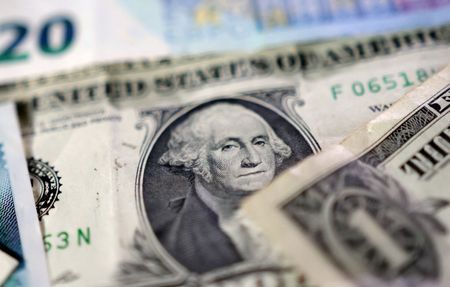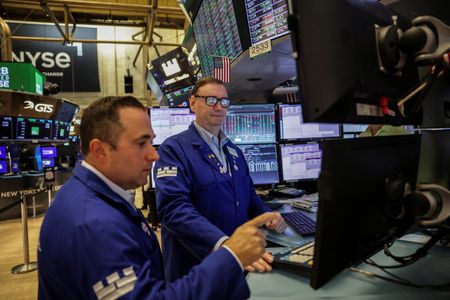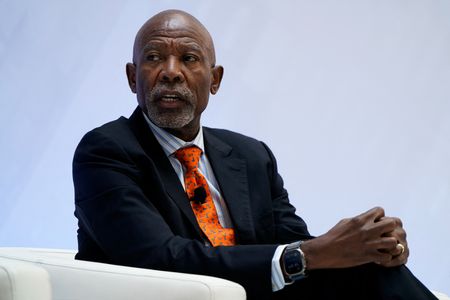By Stefano Rebaudo
(Reuters) -The dollar edged down against the euro and yen on Wednesday after hitting multi-week highs the previous day, as investors awaited producer price data later in the session for clues on potential tariff-driven inflation.
Data on Tuesday showed substantial increases in prices of heavily imported items, shoring up the dollar and driving U.S. rates higher.
Meanwhile investors priced in 44 bps worth of Fed easing by December, down from 50 bps at the start of the week.
“Higher tariff-related goods inflation justifies their (the Fed) more cautious stance, while continued disinflation across services categories should support rate cuts in September and beyond,” said Tiffany Wilding, economist at PIMCO.
“We believe the fact that inflation is more concentrated in core goods categories will make it easier for the Fed to communicate why they are cutting rates while inflation is above target,” she added.
The market focus is now on U.S. producer price data to be released later in the day, which may indicate whether price pressures are beginning to pick up.
Against the yen, the greenback was down 0.1% at 148.65 after hitting a 3-1/2-month peak of 149.19.
Investors in Japanese government bonds were bracing for a potential power shift in upper house elections this weekend that could strain already frail finances.
The euro snapped a 5-day losing streak, and was up 0.14% at $1.1616.
Tariff negotiations are in focus, with market participants expecting the average level of trade duties to be between 10% and 15%. Meanwhile, EU trade chief Maroš Šefčovič is en route to Washington for talks.
Analysts said persistent 30% U.S. tariffs could prompt investors to increase bets on European Central Bank rate cuts, potentially by another 25 basis points.
Against a basket of currencies, the dollar fell 0.10% to 98.54, after hitting 98.699 on Tuesday, its highest since June 23.
“Barring a recession, we expect core goods inflation to increase further in the coming months, but not to the extent that it would prevent the Fed from resuming its easing cycle later this year,” said Frederik Ducrozet, head of macroeconomic research at Pictet Wealth Management.
Also weighing on investors’ minds was the prospect that Fed Chair Jerome Powell’s eventual successor could be more inclined to lower interest rates.
Trump has railed against Powell for months for not easing rates and said on Tuesday that cost overruns on a $2.5 billion renovation of the Fed’s Washington headquarters could amount to a firing offence.
“Trump’s attacks on the Fed’s independence are unlikely to stop,” said Michael Pfister, forex analyst at Commerzbank.
“A 25-basis-point cut is unlikely to satisfy him given that he is demanding 300 basis points lower rates. Accordingly, the current recovery phase (of the U.S. dollar) is unlikely to last long as well,” he added.
In trade, Indonesia reached a deal with the United States after an “extraordinary struggle” in talks which resulted in a reduction of proposed U.S. tariff rates on Indonesian goods to 19% from 32%.
(Reporting by Stefano Rebaudo; Editing by Louise Heavens and Bernadette Baum)









